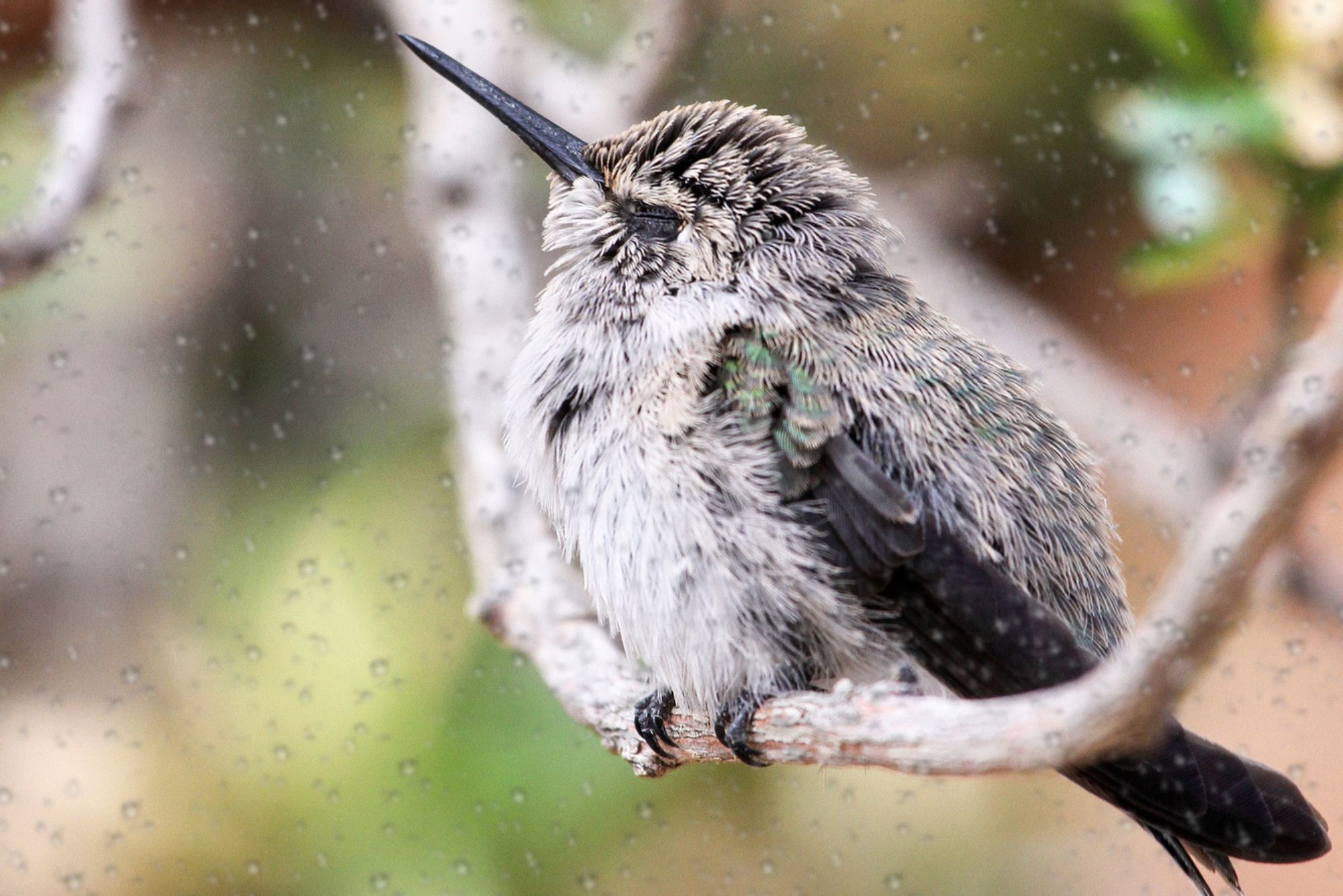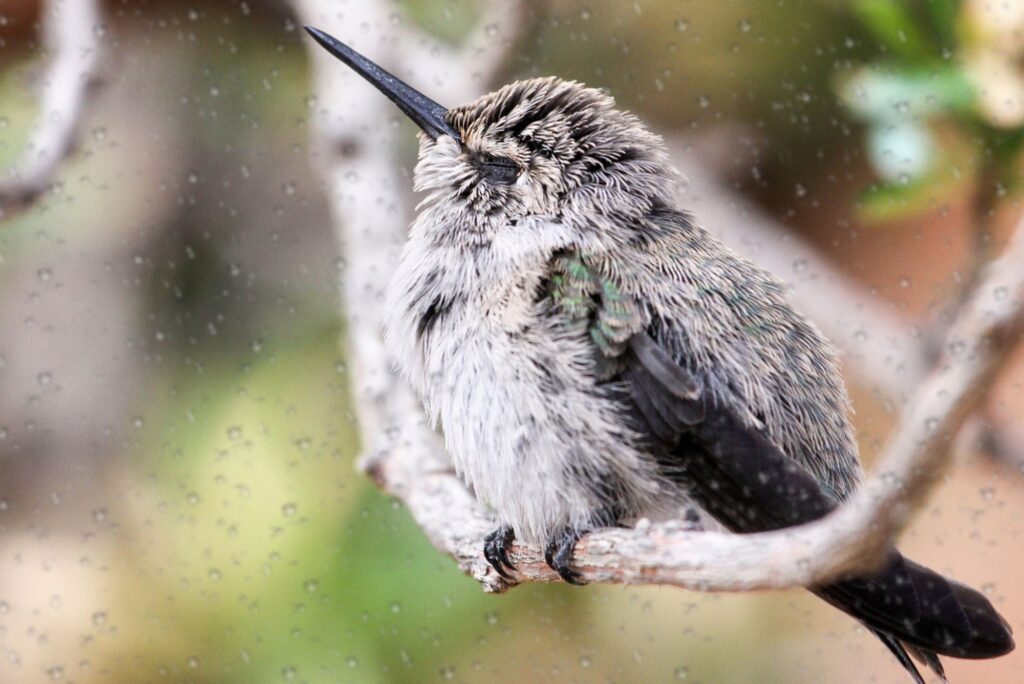If you love hummingbirds as much as we do, you want to know as much as possible about these beautiful little birds.
One question that may spring to mind when you see hummingbirds flitting around your garden in sunny weather is what hummingbirds do when it rains. What do hummingbirds do on a rainy day? Where do they sleep when it rains?
Is Rain a Problem for Hummingbirds?
The good news for those looking out for their wild bird friends is that hummingbirds, though small, are far more resilient than they look.
Like many other creatures, these beautiful birds typically seek shelter to escape the heaviest deluges. But a little rain isn’t a problem, and they can withstand wet weather far more easily than you might imagine.
Whether out and about in it, sheltering, or sleeping protected from the storm, hummingbirds can take wet weather in their stride.
What Do Hummingbirds Do on a Rainy Day?
While they are active, feeding and looking for food, and during migrations, their activities when it rains depend on whether we are talking about drizzle, mild-to-moderate rain, or heavy downpours.
What Hummingbirds Do in Light Rain
Hummingbirds generally continue business as usual in light rain and even during moderate showers. They often enjoy a light shower during the summer months since it can give them some respite from the heat. It also gives them a chance to fly and feed while using less precious energy than they would when it is sweltering.
As the rain gets a little heavier, they may stick to more sheltered spots and preferentially use feeders or seek out sheltered food sources. But in general, even moderate rainfall will not stop them from flying.
What Hummingbirds Do in Heavy Rain
However, hummingbirds (just as we do) head for shelter when the rain gets heavier. They pick any spot protected from the storm where they can perch out of the elements.
Often, they will choose a spot hidden below the leaves of trees or shrubs, with their feet holding firmly to a thin branch for hours. But they will not be picky – whether natural or artificial, any place out of the elements will do.
During the day, adult hummingbirds may sometimes ‘sleep’ if bad weather sets in. ‘Sleeping,’ or entering a dormant state called ‘torpor,’ allows them to conserve energy while not actively feeding. However, hummingbirds usually just perch and wait for the rain to end. Then, as soon as the rain softens, they will be right back out there flying and feeding again.
Heavy rain won’t hurt hummingbirds, but they need more energy to fly when it soaks their feathers. If necessary, they can adapt their flight, increasing the number of wing beats per second and holding their wings at a different angle, so they don’t take on as much water.
But this is a rare sight since it takes a lot of energy, and hummingbirds usually prefer to just stay out of the pouring rain. This strategy is usually only glimpsed when hummingbirds have to make their way through heavy rain to find shelter.
How Does Rain Affect a Hummingbird’s Flight?

In light and mild-to-moderate rain, hummingbirds’ flight will remain normal. These hardy birds can fly just as they usually do.
Like other birds, a hummingbird’s feathers can repel water through their natural design and the oils they distribute during preening. But though they repel water to an extent, they are not entirely waterproof.
Amazingly, however, hummingbirds can shake off water. They can move their feathers back and forth and remove almost all the rain from their plumage in just one-tenth of a second. The striking thing is that they can do this while at rest and in flight.
Scientists have observed this fascinating bird species in flight during different levels of rainfall. In light rain, hummingbirds did not have to change their body position or flight movement. However, hummingbirds have been observed altering body position and wing speed in heavy rain. The raindrops themselves don’t hurt the birds or cause them injury.
Heavy rain won’t stop them from getting from point A to B. But it will take more energy for them to do so and lead to less efficient flight, which is why they will generally avoid it if they can.
Where Will Hummingbirds Sleep During Wet Weather?
Before it gets dark, hummingbirds seek out shelter. When it rains, they follow this typical pattern just as they do when the weather is good.
Exhibiting the same behaviors they do at nightfall, they find a spot as dry and sheltered as possible, typically under a canopy of trees or shrubs, and perch close to the ground or on horizontal tree branches.
They take a firm grip with their feet and typically enter a sleep-like state of torpor before they ‘awake’ or leave this state, around dawn the following day. Hummingbirds sleep or enter into torpor between 8 and 16 hours daily, varying significantly depending on the area, the conditions, and the time of year.
Sometimes, hummingbirds will enter a light torpor, but more profound torpor causes their metabolic rate, temperature, and other bodily functions to drop far more significantly; very helpful during cold weather or on cold nights up north.
Astonishingly, the body temperature of a hummingbird in torpor can drop from 104°F (40°C) to 65°F (18°C).
What Do Hummingbirds Do in Severe Storms and Hurricanes?
Amazingly, hummingbirds can find shelter and cling to twigs or other perches during torpor with a very tight grip. They have even been observed entirely upside down without letting go or dropping off.
Of course, hummingbirds will head to as sheltered a spot as possible during severe storms and hurricanes. They can make it through even the most extreme weather unscathed in such a location. They are very good at finding a sheltered spot on the leeward side of tree trunks protected by surrounding vegetation or other features.
Large numbers of hummingbirds have been seen feeding on hummingbird feeders in the eye of a storm, which is a testament to the humble hummingbird’s resilience in the face of extreme weather conditions.
So take some time to ensure you have plants providing nectar for hummingbirds and attracting the insects they like to eat. Also, include features like fresh water for bathing and cooling off and plenty of shrubs and trees for hummingbirds to perch on and use as shelter when it rains heavily.
A hummingbird-friendly garden can go a long way to protect and preserve the hummingbirds we all love to see.

